Democratizing Tech
How digital public goods can benefit citizens, governments, and business

Digitizing government services and processes is crucial to delivering greater efficiency and increased economic competitiveness, bridging equality gaps, and meeting the changing needs of citizens. Yet many government solutions failed the stress test of the pandemic, wasting scarce resources and adding to suffering.
This is accelerating the adoption of Digital Public Goods (DPGs) – open technology solutions and platforms that transform the delivery of services in areas as diverse as financial services, healthcare, digital identity, education, and climate action. DPGs reduce potential dependence on large, global tech giants, empowering countries to adopt digital infrastructure solutions that they control themselves.
The OECD defines Digital Public Goods as “types of open-source software, AI models, and standards that countries can use to operationalize their Digital Public Infrastructure (DPI), such as payment and data exchange systems.”
Over 80 countries have launched DPG GovTech initiatives since 2014, and while the majority of these are low- to middle-income countries, such as India and Singapore, they also include Estonia, France (Data Gouv), the UK (GDS), and the US (with the health insurance exchanges created through the Affordable Care Act).
As governments take a bigger role in the lives of their citizens, DPGs help create a more open, participatory, trustworthy, and inclusive social ecosystem, while contributing to meeting the UN’s Sustainable Development Goals, particularly around poverty and healthcare.
DPGs also provide enormous transformative opportunities, opening up new markets for organizations as suppliers and participants. This article focuses on the opportunities that DPGs bring for both governments and businesses.
The changing face of Digital Public Goods
Digital public infrastructure (DPIs) and DPGs have existed since 2001, with Estonia a European pioneer in developing and managing distributed data exchanges between public and private organizations. Other countries have adopted DPGs to enable contactless payments, manage citizen health, provide digital identity, and improve the distribution of benefits. Digital public infrastructure has become as vital to the 21st century as railways, roads, and bridges were in the 19th and 20th centuries.
Demonstrating the scale of DPIs, in January 2023 India carried out 8 billion digital payment transactions worth USD200 billion through its Unified Payments Interface DPG, which involved 300 million people and 50 million merchants.
Three factors have accelerated interest in DPGs
1. Pandemic disruption found existing solutions wanting
Many countries struggled with outdated legacy tech during the pandemic, resulting in inefficiencies in the delivery of public services. However, countries such as India, which had the entire technology stack ready, with DPGs covering digital payments, e-Health systems, national identity, and e-Know Your Customer (KYC) (Figure 1), were able to outperform those that relied on closed legacy systems.
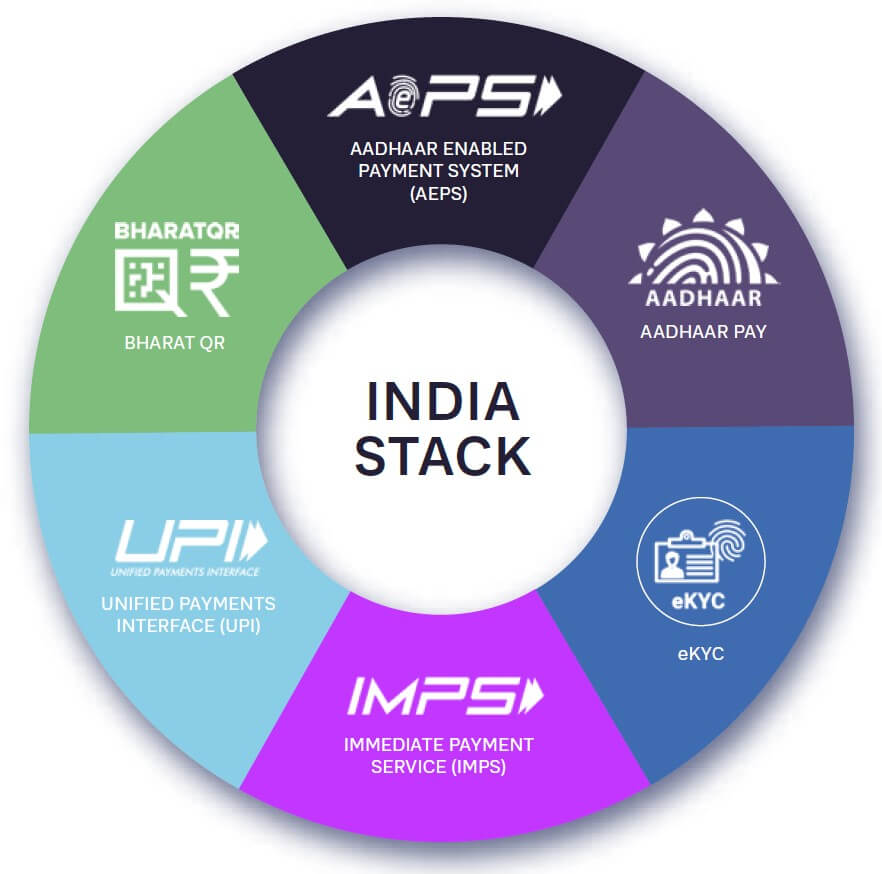
2. A desire for digital sovereignty
When choosing core technology, vendor lock-in is a key concern for many governments, particularly if suppliers are global, rather than locally based. As solutions hold increasing volumes of sensitive data about citizens, data sovereignty is also moving to the top of government requirements. Countries need to know where information is stored, who has access to it, and how it is controlled. As DPGs are open, they can be adopted and adapted across countries – for example, Estonia’s X-Road data exchange platform has also been rolled out in Japan, Finland, Iceland, and the Faroe Islands.
3. Greater funding and international focus
The 2022 UN Future of Digital Co-operation saw greater focus and funding for DPGs from a wide range of NGOs. Major donors, including the Bill & Melinda Gates Foundation, UNICEF Ventures, USAID, and the Omidyar Network, committed around USD300 million in total to DPG/DPI initiatives during the 77th United Nations General Assembly in 2022.
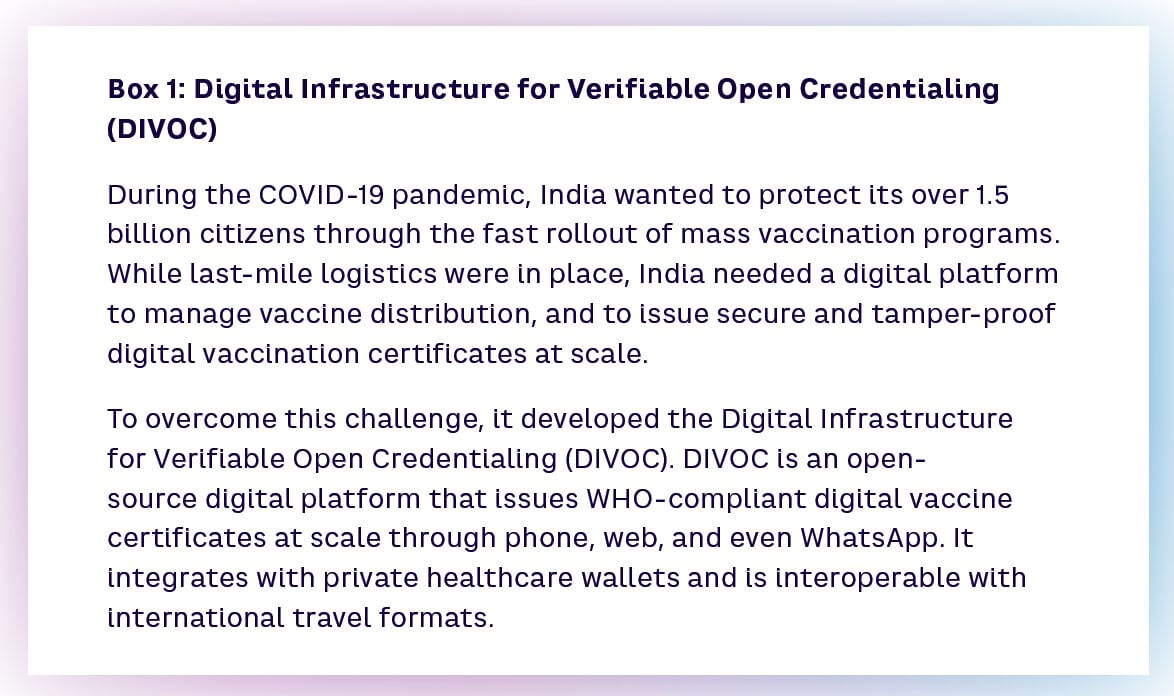
Understanding the public and private sector benefits of DPGs
Benefits for citizens and governments
DPGs either replace proprietary technology solutions or digitize previously paper-based processes. For nations and their citizens, they:
-
Improve the delivery of public services
-
Enable digital inclusion and support the achievement of Sustainable Development Goals, even for those at the bottom of the pyramid
-
Enhance transparency and accountability
-
Increase efficiency by making processes faster, digital, and secure, as well as cutting fraud and eliminating paperwork
-
Improve cybersecurity and data protection
The public benefits of DPGs are clear. For example, Estonia’s digital signature-based e-ID system has resulted in savings of approximately 2 percent of GDP for the government. The IMF estimates that India saved USD34 billion (1.1 percent of GDP) between 2013 and March 2021 by reducing welfare payment fraud through its Aadhaar payment DPG.
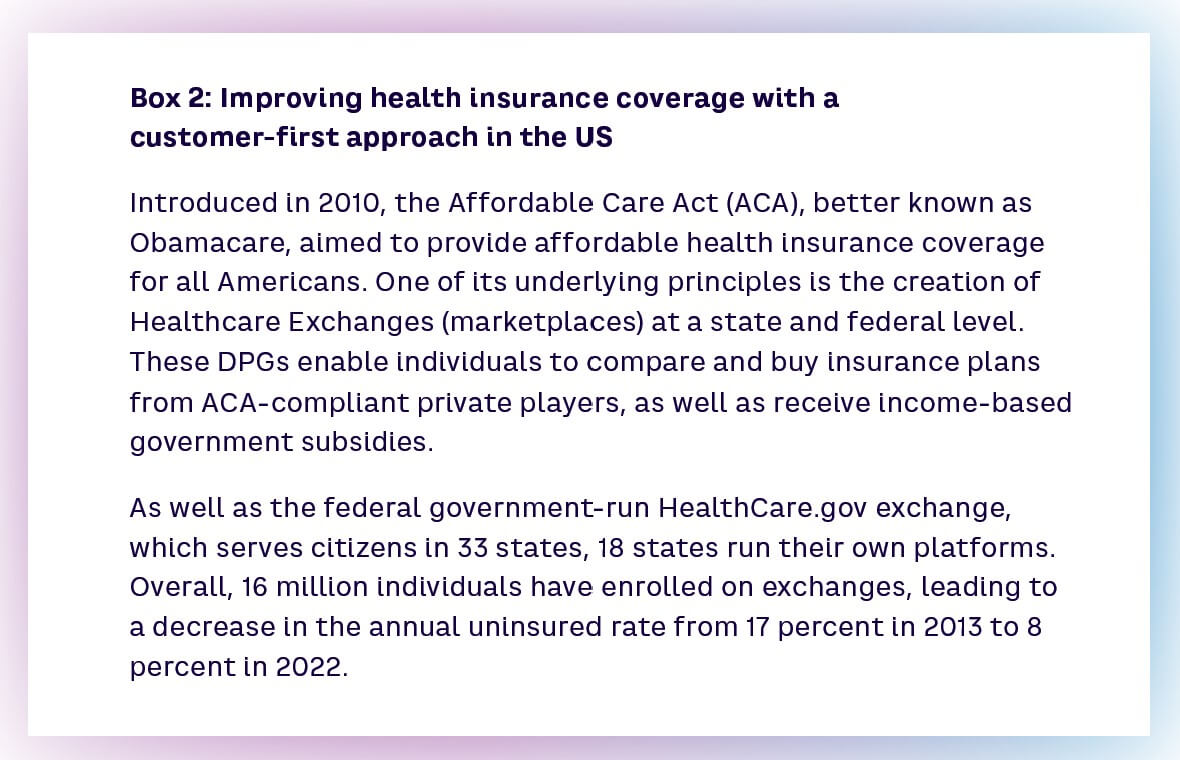
Benefits for businesses
The benefits for the private sector can be less well-understood. DPGs help to drive innovation, increase efficiency, and improve customer satisfaction in four key ways:
1. By providing a level playing field for start-ups and SMEs
By making their platforms open and accessible to all, DPGs open up opportunities for all businesses. For example, India’s Unified Payments Interface (UPI) enables everyone to make and accept digital financial transactions. This means even street vendors can accept digital transactions cost-effectively, without requiring sophisticated, expensive point-of-sale solutions.
2. By fostering innovation and entrepreneurship
Companies can leverage the technology stack/open-source framework created by DPGs to build their own innovative products on top more quickly and efficiently. For example, Walmart-owned PhonePe, Google, Amazon, WhatsApp, and Paytm are building platforms based on the Indian UPI framework.
3. By reducing operational costs and required investment
As DPGs are freely available open-source software and platforms, businesses can easily incorporate them into their products or services. This reduces technology costs, allowing businesses to focus investment in other areas. Indian banks and telcos use DPGs such as Aadhaar-based digital ID and consent-dependent data exchange systems to perform new customer verification checks electronically. This has brought down the cost of verification from USD 6–9 per person to just 40 cents.
4. By providing a more secure and trustworthy environment
DPGs provide secure digital infrastructure for businesses, enabling them to securely store and manage sensitive data, as well as comply with data privacy regulations and standards such as GDPR and ISO 27001. For example, Singapore’s OpenAttestation, a DPG for document verification using blockchain, ensures the authenticity and integrity of digital documents, making legal compliance easier for businesses, particularly around trade finance.
The challenges to delivering a successful DPG
Given their scale, potential complexity, and use of personal information, creating a DPG/DPI is not straightforward, as Figure 2 explains.
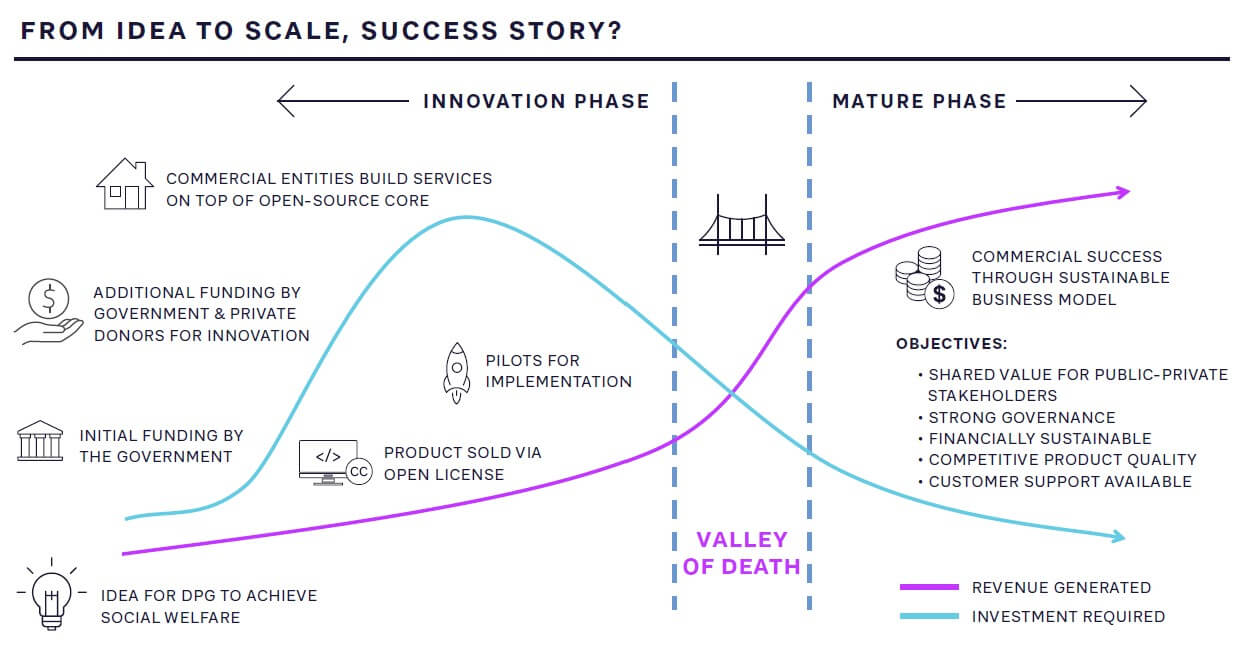
Five main challenges must be overcome:
1. Finance
Developing and maintaining a DPG requires large upfront investment. Owners have to finance development and build a sustainable business model, independent of government budgetary support. Changes in government priorities, especially in the early phases of projects, can also have a negative effect on DPG development.
2. Privacy and security
With the increasing use of technology to collect, store, and share personal data, governments must ensure that appropriate data privacy and security measures are in place. DPIs, especially national identity databases (such as e-ID in Estonia), contain sensitive biometric information that needs extra layers of security protection. APIs linked to this data must be carefully designed to prevent the misuse of sensitive personal information.
3. Digital inclusion
DPGs require citizens to have a combination of Internet access, digital literacy, and digital devices. Governments need to ensure basic Internet infrastructure is in place across their entire population, as well as ensure that DPGs can be accessed at slow Internet speeds and without requiring any additional devices. Rwanda has rolled out infrastructure to provide 96 percent 4G coverage, while Tanzania has adapted digital health services so they work on its low-bandwidth 2G/3G networks.
4. Governance
DPGs are non-rivalrous resources managed by sovereign entities, making strong, transparent governance vital. Governments need to ensure that platforms are equitable, secure, effective, usable, and cost-effective. Owners need to balance the competing needs of different stakeholders with their finite capacity and resources to maximize benefits for all.
5. Technology
DPGs and DPIs are major technology projects. Even if they are based on existing open-source DPGs from other countries, these will need to be adapted and customized to the specific needs of the local population. Managing this scale and complexity is a major challenge that needs to be addressed through investment in resources and skills.
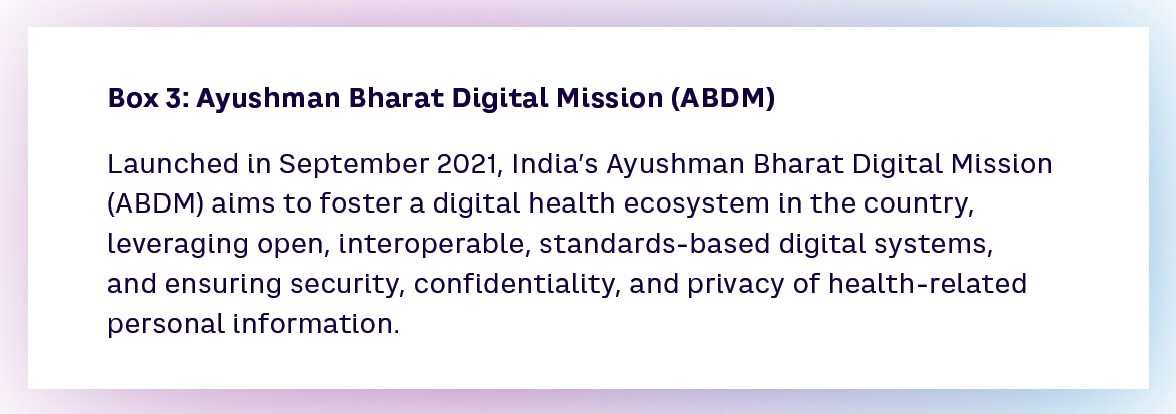
It covers three areas, enabling:
-
Interoperable health services via a Unified Health Interface (UHI), allowing consumers to access any participating healthcare provider
-
Interoperable health data via Health Information Exchanges (such as personal health records, public health data, and anonymized datasets for machine learning)
-
Interoperable health claims via Health Claim Exchanges, standardizing information interchange between payers and providers
Over the past 18 months, the ABDM program has significantly scaled up, creating over 400 million Health IDs and registering 200,000+ health facilities and 180,000+ healthcare professionals.
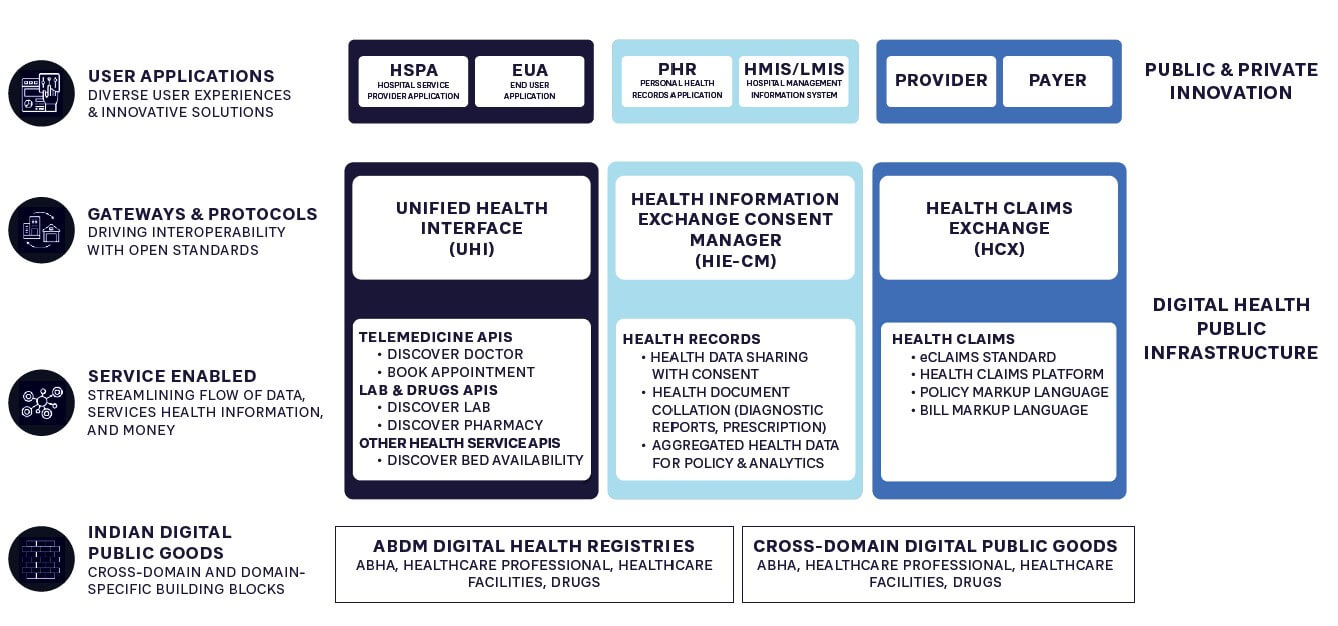
Achieving success for the public and private sector
Government
Based on global experience, governments need to focus on four key dimensions while building DPGs:
1. Build it as an ecosystem
While governments fund the initial development of DPGs, they often lack the incentives to scale solutions. To overcome this, DPGs require a self-sustaining business model, delivered through the creation of an open marketplace or ecosystem. This provides the opportunity to drive scale and revenues. The India Stack (Figure 1) typifies this approach, working with private players to build a sustainable, financially viable solution.
2. Scalable, interoperable infrastructure with minimal blocks
DPGs should be built using open-source and modular technologies, facilitating the exchange of information between the public and private sector, and be adaptable across countries. South Africa’s District Health Information Software 2 (DHIS2) is a prime example of this trend. Overseen by Norway’s University of Oslo, it is presently the largest global platform for health management information and has been adopted in 73 countries, accounting for 30 percent of the global population.
3. Partner with private players
Private sector players can bring new ideas and technologies that can lead to better functionality and scaling of DPG initiatives. For example, the government of Singapore has partnered with players such as IBM and Microsoft to develop and implement blockchain-based solutions for document verification and supply chain management. Private players helped design and implement the technology, while the government provided the necessary regulatory framework and support.
4. Leverage global cooperation
Digital public goods are available to be freely adopted and adapted by governments across the world. Instead of reinventing the wheel, governments should try to leverage existing DPG initiatives, enabling savings on resources and faster implementation. The mass rollout of the DIVOC system beyond India to Sri Lanka, Jamaica, Indonesia, and the Philippines demonstrates the strength of this approach.
Private sector
The rise of DPGs provides private sector organizations with opportunities to innovate and create new use cases in four key areas:
1. Enable new business opportunities
Private players can grow their business and generate additional revenue streams, whatever their size. DPG initiatives often target underserved populations, providing an opportunity for the private sector to tap into new markets. For example, India’s Open Network for Digital Commerce (ONDC) aims to create an interoperable network for digital commerce and includes participants such as Amazon and Flipkart (owned by Walmart).
2. Leverage DPGs to improve customer choice and build trust
DPGs transform industries and provide access to greater consumer choice, while creating deeper trust. Obamacare’s Healthcare Exchanges have allowed private sector insurers to offer competitive healthcare plans, while consumers have been empowered to make better buying decisions.
3. Improve business efficiency and reduce costs
DPGs enable private sector players to improve business efficiency by streamlining operations and automating processes. For example, Estonia’s X-Road allows for secure data exchange between government agencies and with private sector businesses. Businesses can submit regulatory documents online, reducing paperwork, improving transparency, and decreasing corruption risks.
4. Innovate
Companies can build applications on top of DPIs/DPGs, which enables them to innovate cost-effectively. Google developed its Google Pay app running on India’s UPI DPI, differentiating it by adding its own innovative features, such as rewarding customers for using the app to make payments. This has enabled Google to acquire new customers and create revenues from channels such as advertising.
Insights for the Executive
For governments:
-
Understand that DPGs deliver benefits for all countries – they are not solely the province of low-/middle-income countries.
-
Be ambitious and look at where DPGs and DPIs can transform efficiency, relationships with citizens, and overall effectiveness and create a bold vision for national adoption.
-
Understand currently available DPGs and see if they can be adapted to particular needs.
-
Create industry-wide specific roadmaps for DPG and DPI rollouts, and explore innovative institutional mechanisms to drive scale-up and adoption.
For CEOs:
-
Build knowledge of current and planned DPGs in existing and potential markets – how can they create new opportunities?
-
Understand and plan for any competitive threats from the adoption of DPGs.
-
Partner with governments/DPGs where possible to maximize ecosystem benefits.
-
Innovate around DPG ecosystems and use them to build new products, solutions, and revenues.

Democratizing Tech
How digital public goods can benefit citizens, governments, and business

DATE

Digitizing government services and processes is crucial to delivering greater efficiency and increased economic competitiveness, bridging equality gaps, and meeting the changing needs of citizens. Yet many government solutions failed the stress test of the pandemic, wasting scarce resources and adding to suffering.
This is accelerating the adoption of Digital Public Goods (DPGs) – open technology solutions and platforms that transform the delivery of services in areas as diverse as financial services, healthcare, digital identity, education, and climate action. DPGs reduce potential dependence on large, global tech giants, empowering countries to adopt digital infrastructure solutions that they control themselves.
The OECD defines Digital Public Goods as “types of open-source software, AI models, and standards that countries can use to operationalize their Digital Public Infrastructure (DPI), such as payment and data exchange systems.”
Over 80 countries have launched DPG GovTech initiatives since 2014, and while the majority of these are low- to middle-income countries, such as India and Singapore, they also include Estonia, France (Data Gouv), the UK (GDS), and the US (with the health insurance exchanges created through the Affordable Care Act).
As governments take a bigger role in the lives of their citizens, DPGs help create a more open, participatory, trustworthy, and inclusive social ecosystem, while contributing to meeting the UN’s Sustainable Development Goals, particularly around poverty and healthcare.
DPGs also provide enormous transformative opportunities, opening up new markets for organizations as suppliers and participants. This article focuses on the opportunities that DPGs bring for both governments and businesses.
The changing face of Digital Public Goods
Digital public infrastructure (DPIs) and DPGs have existed since 2001, with Estonia a European pioneer in developing and managing distributed data exchanges between public and private organizations. Other countries have adopted DPGs to enable contactless payments, manage citizen health, provide digital identity, and improve the distribution of benefits. Digital public infrastructure has become as vital to the 21st century as railways, roads, and bridges were in the 19th and 20th centuries.
Demonstrating the scale of DPIs, in January 2023 India carried out 8 billion digital payment transactions worth USD200 billion through its Unified Payments Interface DPG, which involved 300 million people and 50 million merchants.
Three factors have accelerated interest in DPGs
1. Pandemic disruption found existing solutions wanting
Many countries struggled with outdated legacy tech during the pandemic, resulting in inefficiencies in the delivery of public services. However, countries such as India, which had the entire technology stack ready, with DPGs covering digital payments, e-Health systems, national identity, and e-Know Your Customer (KYC) (Figure 1), were able to outperform those that relied on closed legacy systems.

2. A desire for digital sovereignty
When choosing core technology, vendor lock-in is a key concern for many governments, particularly if suppliers are global, rather than locally based. As solutions hold increasing volumes of sensitive data about citizens, data sovereignty is also moving to the top of government requirements. Countries need to know where information is stored, who has access to it, and how it is controlled. As DPGs are open, they can be adopted and adapted across countries – for example, Estonia’s X-Road data exchange platform has also been rolled out in Japan, Finland, Iceland, and the Faroe Islands.
3. Greater funding and international focus
The 2022 UN Future of Digital Co-operation saw greater focus and funding for DPGs from a wide range of NGOs. Major donors, including the Bill & Melinda Gates Foundation, UNICEF Ventures, USAID, and the Omidyar Network, committed around USD300 million in total to DPG/DPI initiatives during the 77th United Nations General Assembly in 2022.

Understanding the public and private sector benefits of DPGs
Benefits for citizens and governments
DPGs either replace proprietary technology solutions or digitize previously paper-based processes. For nations and their citizens, they:
-
Improve the delivery of public services
-
Enable digital inclusion and support the achievement of Sustainable Development Goals, even for those at the bottom of the pyramid
-
Enhance transparency and accountability
-
Increase efficiency by making processes faster, digital, and secure, as well as cutting fraud and eliminating paperwork
-
Improve cybersecurity and data protection
The public benefits of DPGs are clear. For example, Estonia’s digital signature-based e-ID system has resulted in savings of approximately 2 percent of GDP for the government. The IMF estimates that India saved USD34 billion (1.1 percent of GDP) between 2013 and March 2021 by reducing welfare payment fraud through its Aadhaar payment DPG.

Benefits for businesses
The benefits for the private sector can be less well-understood. DPGs help to drive innovation, increase efficiency, and improve customer satisfaction in four key ways:
1. By providing a level playing field for start-ups and SMEs
By making their platforms open and accessible to all, DPGs open up opportunities for all businesses. For example, India’s Unified Payments Interface (UPI) enables everyone to make and accept digital financial transactions. This means even street vendors can accept digital transactions cost-effectively, without requiring sophisticated, expensive point-of-sale solutions.
2. By fostering innovation and entrepreneurship
Companies can leverage the technology stack/open-source framework created by DPGs to build their own innovative products on top more quickly and efficiently. For example, Walmart-owned PhonePe, Google, Amazon, WhatsApp, and Paytm are building platforms based on the Indian UPI framework.
3. By reducing operational costs and required investment
As DPGs are freely available open-source software and platforms, businesses can easily incorporate them into their products or services. This reduces technology costs, allowing businesses to focus investment in other areas. Indian banks and telcos use DPGs such as Aadhaar-based digital ID and consent-dependent data exchange systems to perform new customer verification checks electronically. This has brought down the cost of verification from USD 6–9 per person to just 40 cents.
4. By providing a more secure and trustworthy environment
DPGs provide secure digital infrastructure for businesses, enabling them to securely store and manage sensitive data, as well as comply with data privacy regulations and standards such as GDPR and ISO 27001. For example, Singapore’s OpenAttestation, a DPG for document verification using blockchain, ensures the authenticity and integrity of digital documents, making legal compliance easier for businesses, particularly around trade finance.
The challenges to delivering a successful DPG
Given their scale, potential complexity, and use of personal information, creating a DPG/DPI is not straightforward, as Figure 2 explains.

Five main challenges must be overcome:
1. Finance
Developing and maintaining a DPG requires large upfront investment. Owners have to finance development and build a sustainable business model, independent of government budgetary support. Changes in government priorities, especially in the early phases of projects, can also have a negative effect on DPG development.
2. Privacy and security
With the increasing use of technology to collect, store, and share personal data, governments must ensure that appropriate data privacy and security measures are in place. DPIs, especially national identity databases (such as e-ID in Estonia), contain sensitive biometric information that needs extra layers of security protection. APIs linked to this data must be carefully designed to prevent the misuse of sensitive personal information.
3. Digital inclusion
DPGs require citizens to have a combination of Internet access, digital literacy, and digital devices. Governments need to ensure basic Internet infrastructure is in place across their entire population, as well as ensure that DPGs can be accessed at slow Internet speeds and without requiring any additional devices. Rwanda has rolled out infrastructure to provide 96 percent 4G coverage, while Tanzania has adapted digital health services so they work on its low-bandwidth 2G/3G networks.
4. Governance
DPGs are non-rivalrous resources managed by sovereign entities, making strong, transparent governance vital. Governments need to ensure that platforms are equitable, secure, effective, usable, and cost-effective. Owners need to balance the competing needs of different stakeholders with their finite capacity and resources to maximize benefits for all.
5. Technology
DPGs and DPIs are major technology projects. Even if they are based on existing open-source DPGs from other countries, these will need to be adapted and customized to the specific needs of the local population. Managing this scale and complexity is a major challenge that needs to be addressed through investment in resources and skills.

It covers three areas, enabling:
-
Interoperable health services via a Unified Health Interface (UHI), allowing consumers to access any participating healthcare provider
-
Interoperable health data via Health Information Exchanges (such as personal health records, public health data, and anonymized datasets for machine learning)
-
Interoperable health claims via Health Claim Exchanges, standardizing information interchange between payers and providers
Over the past 18 months, the ABDM program has significantly scaled up, creating over 400 million Health IDs and registering 200,000+ health facilities and 180,000+ healthcare professionals.

Achieving success for the public and private sector
Government
Based on global experience, governments need to focus on four key dimensions while building DPGs:
1. Build it as an ecosystem
While governments fund the initial development of DPGs, they often lack the incentives to scale solutions. To overcome this, DPGs require a self-sustaining business model, delivered through the creation of an open marketplace or ecosystem. This provides the opportunity to drive scale and revenues. The India Stack (Figure 1) typifies this approach, working with private players to build a sustainable, financially viable solution.
2. Scalable, interoperable infrastructure with minimal blocks
DPGs should be built using open-source and modular technologies, facilitating the exchange of information between the public and private sector, and be adaptable across countries. South Africa’s District Health Information Software 2 (DHIS2) is a prime example of this trend. Overseen by Norway’s University of Oslo, it is presently the largest global platform for health management information and has been adopted in 73 countries, accounting for 30 percent of the global population.
3. Partner with private players
Private sector players can bring new ideas and technologies that can lead to better functionality and scaling of DPG initiatives. For example, the government of Singapore has partnered with players such as IBM and Microsoft to develop and implement blockchain-based solutions for document verification and supply chain management. Private players helped design and implement the technology, while the government provided the necessary regulatory framework and support.
4. Leverage global cooperation
Digital public goods are available to be freely adopted and adapted by governments across the world. Instead of reinventing the wheel, governments should try to leverage existing DPG initiatives, enabling savings on resources and faster implementation. The mass rollout of the DIVOC system beyond India to Sri Lanka, Jamaica, Indonesia, and the Philippines demonstrates the strength of this approach.
Private sector
The rise of DPGs provides private sector organizations with opportunities to innovate and create new use cases in four key areas:
1. Enable new business opportunities
Private players can grow their business and generate additional revenue streams, whatever their size. DPG initiatives often target underserved populations, providing an opportunity for the private sector to tap into new markets. For example, India’s Open Network for Digital Commerce (ONDC) aims to create an interoperable network for digital commerce and includes participants such as Amazon and Flipkart (owned by Walmart).
2. Leverage DPGs to improve customer choice and build trust
DPGs transform industries and provide access to greater consumer choice, while creating deeper trust. Obamacare’s Healthcare Exchanges have allowed private sector insurers to offer competitive healthcare plans, while consumers have been empowered to make better buying decisions.
3. Improve business efficiency and reduce costs
DPGs enable private sector players to improve business efficiency by streamlining operations and automating processes. For example, Estonia’s X-Road allows for secure data exchange between government agencies and with private sector businesses. Businesses can submit regulatory documents online, reducing paperwork, improving transparency, and decreasing corruption risks.
4. Innovate
Companies can build applications on top of DPIs/DPGs, which enables them to innovate cost-effectively. Google developed its Google Pay app running on India’s UPI DPI, differentiating it by adding its own innovative features, such as rewarding customers for using the app to make payments. This has enabled Google to acquire new customers and create revenues from channels such as advertising.
Insights for the Executive
For governments:
-
Understand that DPGs deliver benefits for all countries – they are not solely the province of low-/middle-income countries.
-
Be ambitious and look at where DPGs and DPIs can transform efficiency, relationships with citizens, and overall effectiveness and create a bold vision for national adoption.
-
Understand currently available DPGs and see if they can be adapted to particular needs.
-
Create industry-wide specific roadmaps for DPG and DPI rollouts, and explore innovative institutional mechanisms to drive scale-up and adoption.
For CEOs:
-
Build knowledge of current and planned DPGs in existing and potential markets – how can they create new opportunities?
-
Understand and plan for any competitive threats from the adoption of DPGs.
-
Partner with governments/DPGs where possible to maximize ecosystem benefits.
-
Innovate around DPG ecosystems and use them to build new products, solutions, and revenues.
